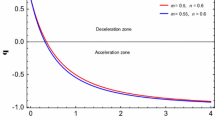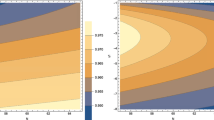Abstract
In this letter, we study the behavior of non-minimally coupled Einstein–Gauss–Bonnet gravity theories with the constant-roll condition. Recalling the results of the striking GW170817 event, we demand that the velocity of the gravitational waves is equated to unity in natural units, meaning that \(c_T^2=1\). This is a powerful restriction since it leads to a decrease in the degrees of freedom and subsequently reveals a connection between the scalar functions of the theory which presumably have different origins. In this framework, we shall assume that a scalar potential is present and can be extracted easily from the equations of motion by simply designating the scalar coupling functions. Obviously, a different approach is feasible but such choice will prove to be extremely convenient. Afterward, we impose certain approximations in order to facilitate our study. Each assumption is capable of producing different phenomenology so a summary of all the possible configurations for Hubble’s parameter, its derivative and the scalar potential along with the corresponding assumptions are present at the end of the paper. We show that compatibility under the constant-roll assumption can be achieved for a variety of model functions and different approaches, although one must always be aware of the imposed approximations since the possibility of a model producing viable results while simultaneously violating even a single approximation exists. Finally, in the end, a new formalism which leads to a plethora of convenient coupling functions according to the readers choice is presented. Utilizing such formalism may lead to new cases for coupling functions which have not been used yet, but are in fact able of producing viable phenomenology for the inflationary era.



Similar content being viewed by others
References
J. Hwang, H. Noh, Phys. Rev. D. 71, 063536 (2005). https://doi.org/10.1103/PhysRevD.71.063536. [arXiv:gr-qc/0412126]
S. Nojiri, S.D. Odintsov, M. Sami, Phys. Rev. D 74, 046004 (2006). https://doi.org/10.1103/PhysRevD.74.046004. [arXiv:hep-th/0605039]
G. Cognola, E. Elizalde, S. Nojiri, S. Odintsov, S. Zerbini, Phys. Rev. D 75, 086002 (2007). https://doi.org/10.1103/PhysRevD.75.086002. [arXiv:hep-th/0611198]
S. Nojiri, S.D. Odintsov, M. Sasaki, Phys. Rev. D 71, 123509 (2005). https://doi.org/10.1103/PhysRevD.71.123509. [arXiv:hep-th/0504052]
S. Nojiri, S.D. Odintsov, Phys. Lett. B 631, 1 (2005). https://doi.org/10.1016/j.physletb.2005.10.010. [arXiv:hep-th/0508049]
M. Satoh, S. Kanno, J. Soda, Phys. Rev. D 77, 023526 (2008). https://doi.org/10.1103/PhysRevD.77.023526. [arXiv:0706.3585 [astro-ph]]
K. Bamba, A.N. Makarenko, A.N. Myagky, S.D. Odintsov, JCAP 1504, 001 (2015). https://doi.org/10.1088/1475-7516/2015/04/001. [arXiv:1411.3852 [hep-th]]
Z. Yi, Y. Gong, M. Sabir, Phys. Rev. D 98(8), 083521 (2018). https://doi.org/10.1103/PhysRevD.98.083521. [arXiv:1804.09116 [gr-qc]]
Z.K. Guo, D.J. Schwarz, Phys. Rev. D 80, 063523 (2009). https://doi.org/10.1103/PhysRevD.80.063523. [arXiv:0907.0427 [hep-th]]
Z.K. Guo, D.J. Schwarz, Phys. Rev. D 81, 123520 (2010). https://doi.org/10.1103/PhysRevD.81.123520. [arXiv:1001.1897 [hep-th]]
P.X. Jiang, J.W. Hu, Z.K. Guo, Phys. Rev. D 88, 123508 (2013). https://doi.org/10.1103/PhysRevD.88.123508. [arXiv:1310.5579 [hep-th]]
P. Kanti, R. Gannouji, N. Dadhich, Phys. Rev. D 92(4), 041302 (2015). https://doi.org/10.1103/PhysRevD.92.041302. [arXiv:1503.01579 [hep-th]]
C. van de Bruck, K. Dimopoulos, C. Longden, C. Owen, arXiv:1707.06839 [astro-ph.CO]
P. Kanti, J. Rizos, K. Tamvakis, Phys. Rev. D 59, 083512 (1999). https://doi.org/10.1103/PhysRevD.59.083512. [arXiv:gr-qc/9806085]
E.O. Pozdeeva, M.R. Gangopadhyay, M. Sami, A.V. Toporensky, S.Y. Vernov, arXiv:2006.08027 [gr-qc]
I. Fomin, arXiv:2004.08065 [gr-qc]
M. De Laurentis, M. Paolella, S. Capozziello, Phys. Rev. D 91(8), 083531 (2015). https://doi.org/10.1103/PhysRevD.91.083531. [arXiv:1503.04659 [gr-qc]]
S. Chervon, I. Fomin, V. Yurov, A. Yurov, https://doi.org/10.1142/11405
K. Nozari, N. Rashidi, Phys. Rev. D 95(12), 123518 (2017). https://doi.org/10.1103/PhysRevD.95.123518. [arXiv:1705.02617 [astro-ph.CO]]
S.D. Odintsov, V.K. Oikonomou, Phys. Rev. D 98(4), 044039 (2018). https://doi.org/10.1103/PhysRevD.98.044039. [arXiv:1808.05045 [gr-qc]]
S. Kawai, M. Sakagami, J. Soda, Phys. Lett. B 437, 284 (1998). https://doi.org/10.1016/S0370-2693(98)00925-3. [arXiv:gr-qc/9802033]
Z. Yi, Y. Gong, Universe 5(9), 200 (2019). https://doi.org/10.3390/universe5090200. [arXiv:1811.01625 [gr-qc]]
C. van de Bruck, K. Dimopoulos, C. Longden, Phys. Rev. D 94(2), 023506 (2016). https://doi.org/10.1103/PhysRevD.94.023506. [arXiv:1605.06350 [astro-ph.CO]]
B. Kleihaus, J. Kunz, P. Kanti, arXiv:1910.02121 [gr-qc]
A. Bakopoulos, P. Kanti, N. Pappas, Phys. Rev. D 101(4), 044026 (2020). https://doi.org/10.1103/PhysRevD.101.044026. [arXiv:1910.14637 [hep-th]]
K. Maeda, N. Ohta, R. Wakebe, Eur. Phys. J. C 72, 1949 (2012). https://doi.org/10.1140/epjc/s10052-012-1949-6. [arXiv:1111.3251 [hep-th]]
A. Bakopoulos, P. Kanti, N. Pappas, arXiv:2003.02473 [hep-th]
W. Ai, [arXiv:2004.02858 [gr-qc]]
S.D. Odintsov, V.K. Oikonomou, Phys. Lett. B 797, 134874 (2019). https://doi.org/10.1016/j.physletb.2019.134874. [arXiv:1908.07555 [gr-qc]]
V.K. Oikonomou, F.P. Fronimos, [arXiv:2007.11915 [gr-qc]]
S.D. Odintsov, V.K. Oikonomou, F.P. Fronimos, Ann. Phys. 420, 168250 (2020). https://doi.org/10.1016/j.aop.2020.168250. [arXiv:2007.02309 [gr-qc]]
V.K. Oikonomou, F.P. Fronimos, [arXiv:2006.05512 [gr-qc]]
S.D. Odintsov, V.K. Oikonomou, Phys. Lett. B 805, 135437 (2020). https://doi.org/10.1016/j.physletb.2020.135437. [arXiv:2004.00479 [gr-qc]]
S.D. Odintsov, V.K. Oikonomou, F.P. Fronimos, [arXiv:2003.13724 [gr-qc]]
S.D. Odintsov, V.K. Oikonomou, F.P. Fronimos, S.A. Venikoudis, Phys. Dark Univ. 30, 100718 (2020). https://doi.org/10.1016/j.dark.2020.100718. [arXiv:2009.06113 [gr-qc]]
R. Easther, K. Maeda, Phys. Rev. D 54, 7252 (1996). https://doi.org/10.1103/PhysRevD.54.7252. [arXiv:hep-th/9605173]
I. Antoniadis, J. Rizos, K. Tamvakis, Nucl. Phys. B 415, 497 (1994). https://doi.org/10.1016/0550-3213(94)90120-1. [arXiv:hep-th/9305025]
I. Antoniadis, C. Bachas, J.R. Ellis, D.V. Nanopoulos, Phys. Lett. B 257, 278–284 (1991). https://doi.org/10.1016/0370-2693(91)91893-Z
P. Kanti, N. Mavromatos, J. Rizos, K. Tamvakis, E. Winstanley, Phys. Rev. D 54, 5049–5058 (1996). https://doi.org/10.1103/PhysRevD.54.5049. [arXiv:hep-th/9511071 [hep-th]]
P. Kanti, N. Mavromatos, J. Rizos, K. Tamvakis, E. Winstanley, Phys. Rev. D 57, 6255–6264 (1998). https://doi.org/10.1103/PhysRevD.57.6255. [arXiv:hep-th/9703192 [hep-th]]
B.P. Abbott et al., Astrophys. J. 848(2), L12 (2017). https://doi.org/10.3847/2041-8213/aa91c9. [arXiv:1710.05833 [astro-ph.HE]]
Y. Akrami et al. [Planck Collaboration], arXiv:1807.06211 [astro-ph.CO]
A. De Felice, S. Tsujikawa, JCAP 1104, 029 (2011). https://doi.org/10.1088/1475-7516/2011/04/029. [arXiv:1103.1172 [astro-ph.CO]]
Author information
Authors and Affiliations
Corresponding author
Appendix
Appendix
We introduce a simple and elegant way of deriving a functional expression of \(\xi (\phi )\). In each approach, it was shown that this particular functions appears in ratios, hence simplifying the ratios facilitates our study greatly. As a result, the first slow-roll index, the e-foldings number and the initial and final value of the scalar field have simple forms. The only requirement is that the coupling scalar function is at least three times differentiable. This particular formalism is shown below,
where \(\lambda \) is a dimensionless parameter and \(X[\phi ]\) is dimensionless arbitrary expression depending on the scalar field. This form was chosen simply because by differentiation with respect to the scalar field, we end up with the following expression,
Thus, the ratio \(\xi '/\xi ''\) which appears in all equations is replaced by the term \(X[\phi ]\). Choosing appropriately this term leads to an easy phenomenology. One can choose to work with such term in order to find an appealing and functional formula for the initial value of the scalar field \(\phi \) and then later derive the expression of the Gauss–Bonnet coupling scalar function by simply integrating Eq. (124).
The same applies to the Ricci coupling function as well. Recall that in certain approaches, the function participates in the form of a ratio \(h'/h\), so extending the previous formalism, one can work with the form,
where \(\Lambda \) a dimensionless constant and \( Y[\phi ]\) a dimensionless arbitrary function of the scalar field. As was with the previous case,
Thus, specifying \(Y[\phi ]\) determines the ratio for Ricci’s coupling function while simultaneously designating its form. Note that changing \(\Lambda \) or \(\lambda \) does not affect the form of the ratio of the coupling functions, or in this case \(X[\phi ]\) and \(Y[\phi ]\). Lastly, concerning a different ratio of the Ricci coupling function, the same approach still applies, although in this case the resulting equation is different. Now,
so choosing an appropriate function which satisfies the above equation can simplify the results greatly. For instance, a linear choice for \(Y[\phi ]\) results in an exponential of a trigonometric function which makes this ratio constant, as was the case with the second model.
In view of this formalism, one is capable of working the other way around. Instead of guessing the coupling functions, the user chooses what they think of as an appropriate feature for the ratio and once this designating yields functional or elegant results, work backward in order to find the coupling scalar functions responsible for such results. In the non minimal case, the task is more difficult since these two forms, \(X[\phi ]\) and \(Y[\phi ]\) could have constructive or destructive behavior so choosing wisely both is the key to elegant phenomenology. This is because choosing appropriately both forms could simplify greatly the results. The choice is obviously up to the reader.
Rights and permissions
About this article
Cite this article
Oikonomou, V.K., Fronimos, F.P. Non-minimally coupled Einstein–Gauss–Bonnet gravity with massless gravitons: the constant-roll case. Eur. Phys. J. Plus 135, 917 (2020). https://doi.org/10.1140/epjp/s13360-020-00926-3
Received:
Accepted:
Published:
DOI: https://doi.org/10.1140/epjp/s13360-020-00926-3




